Black-bellied whistling duck
| Black-bellied whistling duck | |
|---|---|
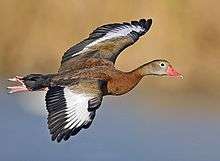 | |
| Northern subspec cycleies (D. a. fulgens, note brown breast). The white wing patch, a tell-tale feature of this species, is conspicuous in flight. | |
| Scientific classification | |
| Kingdom: | Animalia |
| Phylum: | Chordata |
| Class: | Aves |
| Order: | Anseriformes |
| Family: | Anatidae |
| Genus: | Dendrocygna |
| Species: | D. autumnalis |
| Binomial name | |
| Dendrocygna autumnalis | |
| Subspecies | |
|
D. a. autumnalis (Linnaeus, 1758) | |
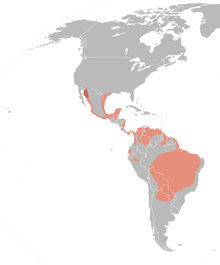 | |
| Range of D. autumnalis Non-resident Breeding range Resident range | |
| Synonyms | |
|
Anas autumnalis Linnaeus, 1758 | |
The black-bellied whistling duck (Dendrocygna autumnalis), formerly also called black-bellied tree duck, is a whistling duck that breeds from the southernmost United States and tropical Central to south-central South America. In the USA, it can be found year-round in parts of southeast Texas, and seasonally in southeast Arizona, and Louisiana's Gulf Coast. It is a rare breeder in such disparate locations as Arkansas, Georgia, Tennessee, and South Carolina, though it is now a common breeder in parts of central Florida. There is a large population of several hundred that winter each year in Audubon Park in uptown New Orleans, Louisiana. Since it is one of only two whistling-duck species native to North America, it is occasionally just known as the "whistling duck" or "Mexican squealer" in the southern USA.
Description
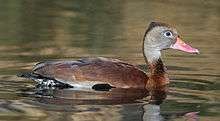
The black-bellied whistling duck is a mid-sized waterfowl species. Length ranges from 47 to 56 cm (19 to 22 in), body mass from 652 to 1,020 g (1.437 to 2.249 lb) and wingspan ranges from 76 to 94 cm (30 to 37 in).[2][3] It has a long red bill, long head and longish legs, pale gray head and mostly gray-brown plumage. The belly and tail are black, and the body plumage, back of the neck and cap are a rich chestnut brown. The face and upper neck are gray, and they sport a thin but distinct white eye-ring. The extensive white in the wings is obvious in flight, less so on the ground; it is formed by the secondary remiges while the primaries are black; the wing-coverts are brown. Males and females look alike; juveniles are similar but have a gray bill and less contrasting belly.
The wing bar is unique among living whistling ducks. When on the ground, it may be hard to discern the light flanks present in many of these waterfowl. The fulvous whistling duck (D. bicolor) is the only sympatric whistling duck that shows such a whitish flank stripe, and it differs from the black-bellied by having dark wings and a lighter belly rather than the other way around. Juvenile D. autumnalis are quite similar to young of the white-faced whistling duck (D. viduata), which have a darker bill and no white wing patch; even when sitting they never seem to show white along the sides, as their thin white vertical barring on the black flanks is very indistinct.
As the name implies, these are noisy birds with a clear whistling waa-chooo call.
Subspecies
There are two subspecies, which intergrade in Panama:
- Northern black-bellied whistling duck, D. a. fulgens – Southern USA to Western Panama.[4]
- Larger, with a brown breast and upper back.
- Southern black-bellied whistling duck, D. a. autumnalis – Eastern Panama to Paraguay and adjacent regions.
- Smaller, with gray breast and upper back.
Prior to 1978, birds from western Panama north to the southern USA were erroneously referred to as D. a. autumnalis and birds from eastern Panama into South America were referred to as D. a. discolor.[5]
Ecology
.jpg)
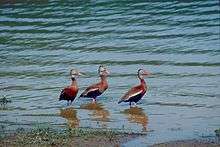
The black-bellied whistling duck is a common species that is "quite tame, even in the wild".[6] It is highly gregarious, forming large flocks when not breeding, and is largely resident apart from local movements. It usually nests in hollow trees (in South America many times in palm trees). The habitat is quiet shallow freshwater ponds, lakes, and marshes, cultivated land or reservoirs with plentiful vegetation, where this duck feeds mainly at night on seeds and other plant food.
Diet
Feeding often occurs nocturnally, but they can be encountered eating at any hour of the day. Black-bellied whistling ducks ingest a wide variety of plant material, but also consume arthropods and aquatic invertebrates when available. They often feed on submerged vegetation by wading through shallow water. As its Latin name (autumnalis) implies, it is commonly seen gleaning recently harvested fields for leftover seeds and invertebrates brought up by the harvesters disturbing the soil.
Movements
The black-bellied whistling duck is mainly non-migratory. Birds in the extreme northern portions of their range (Arizona, Louisiana, and parts of Texas) move south in winter. At the heart of their range, there is a tendency to travel in flocks over the winter months, though this behavior is not a true long-range migration but rather local dispersal. 7 adults and 8 ducklings were observed on west side of Lake Apopka, Central Florida, 7-24-15. They have been in this area for more than a year.[7] Since 2009, this species has now become a common breeder in Lake County, Florida, with adult pairs with offspring seen by lakes and in wetlands near Eustis, Tavares, Leesburg, and other municipalities; large wintering flocks of 30+ birds can be seen throughout the county, even up to Lake Norris in the NE central portion of the county (Ralph Risch, Biologist II, Florida Forest Service, Lake Forestry Station; personal observation). There has been a large flock noted for about two years in the River Plantation area of Parrish in Manatee County, Florida. A large flock was observed and photographed by a local resident in Audubon Park, New Orleans, Louisiana in February 2016. Over 100 of the whistling ducks have resided in the Gum Slough of Sumter County, Florida for over 2 years.
Reproduction
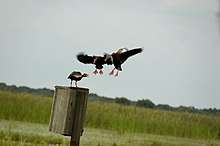
The black-bellied whistling duck is quite unique among ducks in their strong monogamous pair-bond. Its pairs often stay together for many years, a trait more often associated with geese and swans. Both parents share all tasks associated with the raising of young, from incubation to the rearing of ducklings. The ducks, primarily cavity nesters, prefer the confines of a hollow tree, but will nest on the ground when necessary. They also make use of chimneys, abandoned buildings, or nest boxes, the latter having been increasingly provided to them over recent decades, especially in southeast Texas and Mexico. Ducklings leap from nest cavities within two days of hatching, can feed themselves immediately, and stay with the parents for up to eight weeks.
Habitat includes ponds, fresh marshes. Favors shallow freshwater lakes; may come to those in open country, but seems to favor ponds surrounded by trees. Will nest on ground or in tree cavities. When foraging, often in dry fields, also in irrigated land
Status and conservation
This species is not considered to be of conservation concern by the IUCN[1] and the National Audubon Society; its global population is estimated at 1,100,000-2,000,000 birds.[1]
Footnotes
- 1 2 3 BirdLife International (2012). "Dendrocygna autumnalis". IUCN Red List of Threatened Species. Version 2013.2. International Union for Conservation of Nature. Retrieved 26 November 2013.
- ↑ "Black-bellied Whistling-Duck". eNature.com. Archived from the original on 6 June 2014. Retrieved 4 June 2014.
- ↑ "Black-bellied whistling-duck". All About Birds. Cornell Lab of Ornithology.
- ↑ "Twenty-Third Supplement to the American Ornithologists' Union Check-List of North American Birds" (PDF). The Auk. 65: 438–443. July 1948.
- ↑ Banks, Richard C. (April 1978). "Nomenclature of the Black-Bellied Whistling-Duck" (PDF). The Auk. 95: 348–352.
- ↑ Bull, Farrand (1977)
- ↑ visual observations Jim and Karen Holcomb
References
- Bencke, Glayson Ariel (2007): Avifauna atual do Rio Grande do Sul, Brasil: aspectos biogeográficos e distribucionais ["The Recent avifauna of Rio Grande do Sul: Biogeographical and distributional aspects"]. Talk held on 2007-JUN-22 at Quaternário do RS: integrando conhecimento, Canoas, Rio Grande do Sul, Brazil. PDF abstract
- Bull, John; Farrand, John Jr. (1977). National Audubon Society Field Guide to North American Birds (Eastern Region). New York: National Audubon Society. ISBN 0-679-42852-6.
- Madge, Steve; Burn, Hilary (1987). Wildfowl : an identification guide to the ducks, geese and swans of the world. London: Christopher Helm. ISBN 0-7470-2201-1.
External links
| Wikimedia Commons has media related to Dendrocygna autumnalis. |
| Wikispecies has information related to Dendrocygna autumnalis |
- "Black-bellied Whistling-duck media". Internet Bird Collection.
- Black-bellied Whistling-duck photo gallery at VIREO (Drexel University)
